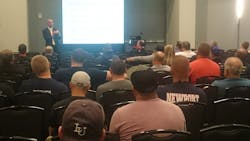Company officers wear many hats, and one of the most critical is that of the instructor. In his Thursday Firehouse Expo session “The Company Officer as an Instructor,” Lt. Brad French of the Dayton, OH, Fire Department offered myriad training ideas and resources that any company officer can easily implement at their station.
Before delving into the drills themselves, French underscored why it is so important for anyone riding in the front right seat to focus on training and educating their crews through drills. “Have an environment around your station where the ‘vibe’ is training—simply what everything else revolves around.” he said. “If you carry the attitude of training, you’re going to be the go-to company.”
French explained that company-level drills are effective ways to regularly evaluate the specific skill sets of your company members, and they reinforce existing SOPs/SOGs. Plus, they are free. “Company-level training doesn’t cost anything but initiative,” he said.
There are plenty of resources available to support these efforts, French said. Specifically, there are institutional resources like SOP/SOG manuals, pump operator manuals/hydraulic charts, manufacturer guides for equipment, district maps and event “street school”-style drills. He offered the real estate section of your local newspaper as a great “street school” resource, explaining that crews can use this section to review routes, tanker shuttle calculations, building construction (reading the building) and estimating fire flow.
French also enumerated several online resources, such as UL Firefighter Safety Research Institute and NIST, emphasizing the importance of modern fire behavior and fire dynamics. “There’s no one I can speak to more directly that you need to understand this stuff,” he said. “You owe it to your personnel and their families.” He lauded the “educational renaissance” currently sweeping the fire service, and underscored that being knowledgeable and passionate about research can rub off on your crewmembers so that they too can have a more global perspective on fire behavior.
He also encouraged thorough review of NIOSH reports. “It is so incredibly important that your mind is a Rolodex of firefighter LODDs,” he said, adding that he should be able to mention any major LODD incident, such as the Sofa Super Store fire or Southwest Supermarket fire, and you know what he’s talking about—and on a deep level.
French reminded that while online training is great, it should not replace the interpersonal communication or hands-on training.
When it comes to in-house drills and evolutions, French recommended conducting this type of training during morning roll call when the crewmembers are most focused—and before they can become distracted by personal conversations. “This is the perfect time to do it because it sets the tone for the day,” he said. The crew can then move onto the other daily tasks, like checking the rig. Although these drills are commonly generated and run by the company officer, they can also be handled by other members as a way to empower them and give them some leadership experience.
As for in-district training, French offered a variety of ideas involving preplanning/building walk-throughs, target hazards, apparatus placement options, aerial scrub area determination and hose stretch estimations. He also recommended using EMS runs as a training ground by having members guess building layout, practice elevator operations, identify the nearest hydrant, and other task that can be handled when en route to or after the call. Of course, he also reminded that getting out and walking around the district is a simple, easy and free way to check out your first-due.
French outlined some drills for different types of operations:
Engine Company Operations
- Pump operator training
- How much time do I really have on the tank water?
- Hose movement—the positioning (nozzle, backup, door)
- Line extension
- Troubleshooting water flow issues
- Alternative stretches (rope stretch, well hole, etc.)
Truck Company Operations
- Downtown high-rise or college campus
- Field trips to the locksmith or hardware store
- Buildings under construction
- Timed drills
- Specialized equipment
French also discussed how to create an environment of excellence in the firehouse. He emphasized finding the A-level players and helping them succeed, recognizing the strengths of your members, leading with enthusiasm, empowering those members who show an eagerness to learn, being an advocate for your team, allowing for some down time every day, and enforcing a chain of command to maintain professionalism in the organization.
In the end, French said it really comes down to taking every opportunity to get out in your district and learn and train. The key is to ensure that you take the time each shift to get it done so the crew understands the importance of training—and that you set the example. “Make sure you’re the officer that others will want to be,” he said.
About the Author

Janelle Foskett
Janelle Foskett served as editorial director of Firehouse Magazine and Firehouse.com, overseeing the editorial operations for the print edition along with working closely with the Web team.
